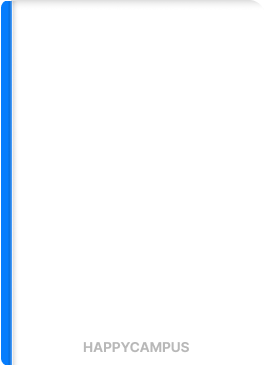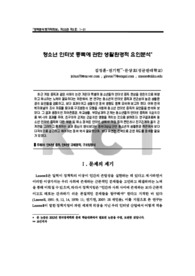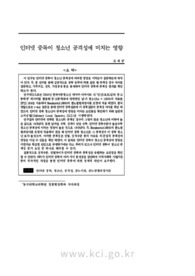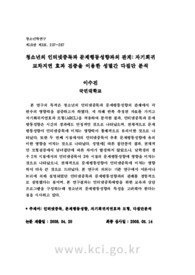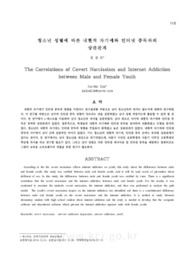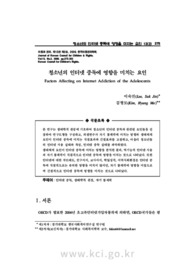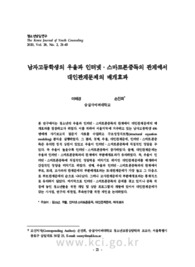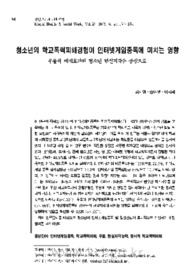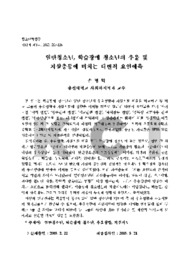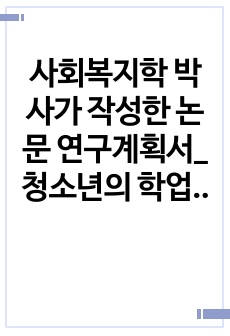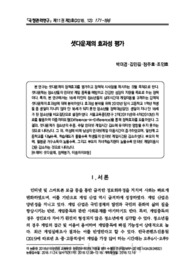

PARTNER
검증된 파트너 제휴사 자료
청소년 인터넷 중독 모형 분석 (The Analysis of Adolescent Internet Addiction Model)
한국학술지에서 제공하는 국내 최고 수준의 학술 데이터베이스를 통해 다양한 논문과 학술지 정보를 만나보세요.
14 페이지
최초등록일 2025.07.07
최종저작일
2005.12

-
미리보기
서지정보
· 발행기관 : 한국상담학회
· 수록지 정보 : 상담학연구 / 6권 / 4호 / 1307 ~ 1320페이지
· 저자명 : 김동일, 정여주
초록
본 연구는 공분산 구조방정식을 활용하여 인터넷 중독 위험에 처해있는 청소년들이 어떠한 경로를 따라 인터넷 중독 현상을 보이고 있는지를 파악하고자 하는 시도로 이루어졌다. 전국 16개 중·고등학교를 대상으로 인터넷 중독 자가진단검사를 실시했으며, 1,666명의 자료를 활용하여 인터넷 중독 모형을 분석하였다. 청소년들은 가상 공간에서의 인정, 친밀감 등의 가상적대인관계지향성과 자유로움, 흥미, 자신감, 스트레스 해소의 긍정적 기대로 인해 인터넷 사용을 시작한다. 지속적으로 인터넷을 사용하게 되면 금단과 내성 증상을 지니게 된다. 금단과 내성 증상을 가진 청소년들은 건강이 나빠지거나, 수업시간에 집중을 하지 못하거나, 일상적인 생활에서 게을러지는 등의 일상생활의 장애를 겪게 된다. 그리고나서 수업을 빠지고, 선생님을 속이고, 인터넷을 하기 위해 돈을 훔치는 등 일탈 행동에 이르게 된다. 일탈 행동에 빠진 청소년들 중 인터넷 사용량이 많아지면, 환상을 보고, 비도덕적 행위를 하는 등 현실구분장애에 이르게 된다.영어초록
Along with increasing the use of Internet, many studies have investigated about the addiction since Young, K. S. presented “Psychology of computer use: Addictive use of the Internet” in 1996. The Internet Addiction was defined operationally as increasing tolerance of long Internet use hours, withdrawal, and showing disturbances of adaptive functioning in daily lives. The Korean public is apprehensive about pathological use of Internet, which results in negative life consequences, such as academic failure, job loss and marriage breakdown. Different from other psychological addictions, Internet Addiction would be akin to pathological gambling as an impulse-control disorder with no involvement of an intoxicant. The purpose of the present study was to develop an Internet Addiction Model through the analysis of Structural Equation Model. This Internet Addiction model could be used to understand how youth people were addicted to Internet and to help teachers and counselors to counsel them. The previous researches supported that Internet Addiction was consisted of 7 factors: Addictive Automatic Thoughts, Virtual Interpersonal Relationship, Disturbance of Adaptive Function, Deviate Behaviors, Tolerance, Withdrawal, and Disturbance of Reality Testing. These factors were divided into three groups: the Preceding Factor, which had Virtual interpersonal relationship and Addictive Automatic Thoughts, the Addiction Symptom, which had Tolerance and Withdrawal, and the Following Factor, which had Disturbance of Adaptive Function, Deviate Behaviors, and Disturbance of Reality Testing. 16 secondary school students took the Internet Addiction-proneness scale, statistical information(22 inquiries), and MMPI Lie scale(12 inquiries). The participants of this study were 1,666 students(from age 13 to 19). As a result of the analysis of Structural Equation Model through AMOS program, the Internet Addiction Model was developed. The model indicated the process of Internet Addiction. The study found that Automatic Addictive Thoughts or Virtual Interpersonal Relationship would serve as a gateway to Internet Addiction. As a matter of fact, adolescents were attracted to the Internet because they thought that friends whom they met in the virtual space would recognize them and having virtual friendship could make them happy. And they believed that they would feel free, become interested, get confidence, and reduce stress through Internet. These two factors made them use Internet continuously. And then adolescents went to the Addiction Symptom stage, which was characterized by Withdrawal and Tolerance. Besides, Internet overuse seemed to cause Disturbances of Adaptive Function and Deviate Behaviors. The Disturbance of Reality Testing was hypothesized as a symptom of severe Internet Addiction. The Internet Addiction Model was statistically sound and valid. This Internet Addiction Model would help counselors to understand students and contribute to design an effective prevention program in the schools and the counseling centers.참고자료
· 없음태그
-
자주묻는질문의 답변을 확인해 주세요

꼭 알아주세요
-
자료의 정보 및 내용의 진실성에 대하여 해피캠퍼스는 보증하지 않으며, 해당 정보 및 게시물 저작권과 기타 법적 책임은 자료 등록자에게 있습니다.
자료 및 게시물 내용의 불법적 이용, 무단 전재∙배포는 금지되어 있습니다.
저작권침해, 명예훼손 등 분쟁 요소 발견 시 고객센터의 저작권침해 신고센터를 이용해 주시기 바랍니다. -
해피캠퍼스는 구매자와 판매자 모두가 만족하는 서비스가 되도록 노력하고 있으며, 아래의 4가지 자료환불 조건을 꼭 확인해주시기 바랍니다.
파일오류 중복자료 저작권 없음 설명과 실제 내용 불일치 파일의 다운로드가 제대로 되지 않거나 파일형식에 맞는 프로그램으로 정상 작동하지 않는 경우 다른 자료와 70% 이상 내용이 일치하는 경우 (중복임을 확인할 수 있는 근거 필요함) 인터넷의 다른 사이트, 연구기관, 학교, 서적 등의 자료를 도용한 경우 자료의 설명과 실제 자료의 내용이 일치하지 않는 경우
“상담학연구”의 다른 논문도 확인해 보세요!
-
‘체형 만족도 평가지(Body Shape Questionnaire: BSQ)’의 타당화 연구-여대생을 중심으로- 12 페이지
본 연구는 한국어로 번안된 ‘체형 만족도 평가지(Body Shape Questionnaire: BSQ)’의 타당화를 목적으로 수행되었다. 서울에 위치한 S 여대생 461명을 대상으로 BSQ를 실시하여 내적 일치도(Cronbach α=.95)와, 112명을 대상으로 2~3주 간격으로 검사-재검사 신뢰도(r=.62, p<.01)를 구하였다. BSQ의 타당도 검.. -
청소년용 여성 진로장벽 척도의 개발 및 구인타당도 검증 20 페이지
본 연구에서는 초․중․고 여학생에게 사용될 수 있는 진로장벽 척도를 개발하고 타당화하였다. 먼저, 문헌연구를 통해 Swanson의 CBI-R(Career Barriers Inventory-Revised)등의 외국 척도와 국내의 진로장벽 척도를 참고하여 자기이해의 부족, 자신감 부족, 성역할 갈등 및 성차별, 중요한 타인과의 갈등, 미래에 대한 불확실성, 진.. -
아동의 수줍음 감소를 위한 집단상담프로그램의 효과 16 페이지
본 연구는 초등학교 아동의 수줍음 감소를 위해 집단상담프로그램을 적용하고 그 효과를 검증해보는 것을 목적으로 한다. 연구의 목적을 달성하기 위하여 초등학교 5학년 학생을 대상으로 수줍음 수준을 파악한 후, 수줍음 수준이 높은 학생들을 1차 대상으로 선정하고, 선정된 학생들 중, 담임교사의 관찰, 본인의 희망 여부를 조사하여 실험집단과 통제집단에 각각 20명.. -
청소년의 흡연, 자아존중감, 적개심 및 우울과의 관련성 분석 94 페이지
본 연구는 청소년의 일반적 특성, 문제 행동 특성 및 심리적 특성에 따른 흡연율을 파악하고, 나아가 청소년의 흡연 관련 주요 요인을 규명하고자 시도되었다. 이를 위해 청소년 1,260명을 대상으로 조사 연구한 결과는 다음과 같다. 먼저 청소년 흡연 행위에서 첫째, 조사대상 청소년의 16.7%가 흡연을 하고 있는 것으로 나타났다. 둘째, 청소년의 흡연율은 일.. -
요가자세법, 호흡법 수련과 신체심리치료의 비교연구 19 페이지
본 연구에서는 요가자세법과 호흡법이 갖는 심리치료 효과를 살펴보기 위하여 이를 신체심리치료와 비교해 보았다. 요가자세법에서는 스트레칭, 이완, 강화, 자각을 심리치료적 요인으로 제시하였으며 요가호흡법에서는 신경계의 정화․강화․안정 및 자각을 치료적 요인으로 설명하였다. 인간을 몸, 마음, 영혼의 통합적 존재로 바라보고 신체를 중심으로 하여 심리적 문제를 다..
찾으시던 자료가 아닌가요?
지금 보는 자료와 연관되어 있어요!
문서 초안을 생성해주는 EasyAI
